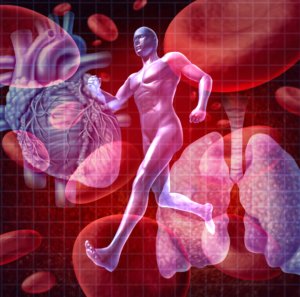Vitamin D is related to oxygen utilization, fitness level, and lifespan
 It is commonly known that vitamin D plays a vital role for our bones and immune system, and there is even evidence that vitamin D also plays a role in the functioning of our lungs, heart, and muscles. According to a new study, blood levels of vitamin D are determining for how well we utilize our oxygen, and that affects our training capacity and lifespan. The study is published in European Journal of Preventive Cardiology.
It is commonly known that vitamin D plays a vital role for our bones and immune system, and there is even evidence that vitamin D also plays a role in the functioning of our lungs, heart, and muscles. According to a new study, blood levels of vitamin D are determining for how well we utilize our oxygen, and that affects our training capacity and lifespan. The study is published in European Journal of Preventive Cardiology.
According to the new study, blood levels of vitamin D are linked directly to our cardiorespiratory fitness level. This refers to the body’s ability to deliver oxygen to the muscles during physical activity. The cardiorespiratory fitness levels is measured as our maximal oxygen consumption during training and is also known as VO2max, which is an expression of the highest possible amount of oxygen (measured in milliliters) that the lungs can take in within one minute.
A person’s fitness rating or exercise capacity is equal to the relative VO2max level that also takes into account a person’s height. It turns out that people with better cardiorespiratory fitness are healthier and live longer, which is most likely because their cells are supplied with more oxygen to help the cellular powerhouses – the so-called mitochondria – produce more ATP. ATP is energy stored chemically inside the cells.
The more vitamin D, the better
In the new study, the scientists wanted to investigate if people with higher blood levels of vitamin D had a higher cardiorespiratory fitness level. They gathered data from a large population study called NHANES (National Health and Nutrition Examination Survey), where researchers had looked at a large section of Americans aged 20-49 years during the period 2001-2004.
The participants were split into four groups, depending on how much vitamin D they had in their blood. The scientists studied data from the approximately 2,000 participants, where 45% were women, 49% where white, 13 % had elevated blood pressure, and 4% were diabetic.
It turned out that the quartile with the highest blood levels of vitamin D had 4-5 higher cardiorespiratory fitness level than the quartile with the lowest amount of vitamin D in their blood. The difference remained statistically significant after adjusting for age, gender, race, BMI, smoking, elevated blood pressure, diabetes, and other confounding factors. The relation between higher blood levels of vitamin D and better training capacity was observed in both men and women, regardless of ethnicity, BMI, and whether or not they had elevated blood pressure and diabetes.
Measurements of vitamin D and the heart’s optimal requirements
Vitamin D levels in the blood are measured as 25-hydroxy-vitamin D. In Denmark, the lower threshold level is 50 nmol/L. The scientists observed that for every 10 nmol/L increase in vitamin D, there was a significant increase in VO2max. The more vitamin D the participants had in their blood, the better their cardiorespiratory fitness level
Dr. Marawan points out that it is an observational study, and he can therefore not simply conclude that vitamin D improves a person’s training capacity. However, he underpins that there seems to be a strong correlation. For that reason, people living at norther latitudes, should pay careful attention to get enough vitamin D during the time of year, where the sun sits too low in the sky to enable the body to synthesize vitamin D in response to sun exposure. On the other hand, he points out, we should be careful not to get too much, as this may cause calcium to accumulate in the blood, resulting in nausea and weakness.
According to De. Marawan, we already know about the importance of having optimal vitamin D levels to support healthy bones, and now we need new studies to show how much vitamin D is needed to help the heart operate optimally. For the sake of the general health of the population, Dr. Marawan also finds it necessary to study if vitamin D enrichment of foods can affect more than bone health alone. Other scientists believe that blood levels of up to 75-100 nmol/L are required to obtain optimal disease prevention, and that calls for higher intake levels than currently suggested.
Supplements and upper safe limit
Many researchers claim that the actual need for vitamin D is higher than the current RI (reference intake) level, and their recommendations for intake of the nutrient vary between 30 and 100 micrograms daily. People with dark skin do not synthesize vitamin D as easily as those, who have lighter skin, and the same is the case with old individuals. Overweight people and diabetics also have difficulty with producing and utilizing vitamin D.
During the winter period, most people need a vitamin D supplement, as there is not enough sunshine, and our diets only provide limit quantities of the nutrient. Because vitamin D is lipid-soluble, we utilize the nutrient best when it is in capsules in some kind of oil.
References:
Amr Marawan et al. Association between serum vitamin D levels and cardiorespiratory fitness in adult population of the USA. European Journal of Preventive Cardiology. October 2018
European Society of Cardiology. Vitamin D levels in the blood linked to cardiorespiratory fitness. ScienceDaily October 30, 2018
https://www.efsa.europa.eu/sites/default/files/assets/UL_Summary_tables.pdf
Steen Ahrenkiel. D-vitamin behov og mangel i Danmark. Biokemisk forskning 2009
Search for more information...
- Created on .








